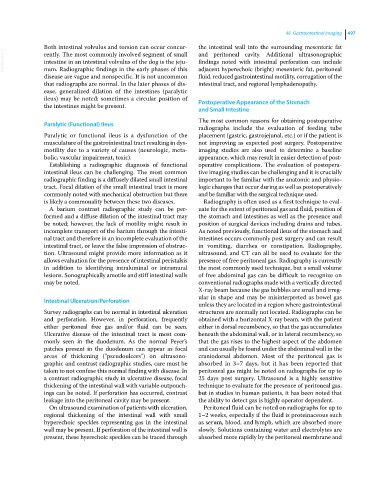Page 529 - Clinical Small Animal Internal Medicine
P. 529
48 Gastrointestinal Imaging 497
Both intestinal volvulus and torsion can occur concur the intestinal wall into the surrounding mesenteric fat
VetBooks.ir rently. The most commonly involved segment of small and peritoneal cavity. Additional ultrasonographic
findings noted with intestinal perforation can include
intestine in an intestinal volvulus of the dog is the jeju
num. Radiographic findings in the early phases of this
fluid, reduced gastrointestinal motility, corrugation of the
disease are vague and nonspecific. It is not uncommon adjacent hyperechoic (bright) mesenteric fat, peritoneal
that radiographs are normal. In the later phases of dis intestinal tract, and regional lymphadenopathy.
ease, generalized dilation of the intestines (paralytic
ileus) may be noted; sometimes a circular position of Postoperative Appearance of the Stomach
the intestines might be present.
and Small Intestine
The most common reasons for obtaining postoperative
Paralytic (Functional) Ileus
radiographs include the evaluation of feeding tube
Paralytic or functional ileus is a dysfunction of the placement (gastric, gastrojejunal, etc.) or if the patient is
musculature of the gastrointestinal tract resulting in dys not improving as expected post surgery. Postoperative
motility due to a variety of causes (neurologic, meta imaging studies are also used to determine a baseline
bolic, vascular impairment, toxic). appearance, which may result in easier detection of post
Establishing a radiographic diagnosis of functional operative complications. The evaluation of postopera
intestinal ileus can be challenging. The most common tive imaging studies can be challenging and it is crucially
radiographic finding is a diffusely dilated small intestinal important to be familiar with the anatomic and physio
tract. Focal dilation of the small intestinal tract is more logic changes that occur during as well as postoperatively
commonly noted with mechanical obstruction but there and be familiar with the surgical technique used.
is likely a commonality between these two diseases. Radiography is often used as a first technique to eval
A barium contrast radiographic study can be per uate for the extent of peritoneal gas and fluid, position of
formed and a diffuse dilation of the intestinal tract may the stomach and intestines as well as the presence and
be noted; however, the lack of motility might result in position of surgical devices including drains and tubes.
incomplete transport of the barium through the intesti As noted previously, functional ileus of the stomach and
nal tract and therefore in an incomplete evaluation of the intestines occurs commonly post surgery and can result
intestinal tract, or leave the false impression of obstruc in vomiting, diarrhea or constipation. Radiography,
tion. Ultrasound might provide more information as it ultrasound, and CT can all be used to evaluate for the
allows evaluation for the presence of intestinal peristalsis presence of free peritoneal gas. Radiography is currently
in addition to identifying intraluminal or intramural the most commonly used technique, but a small volume
lesions. Sonographically amotile and stiff intestinal walls of free abdominal gas can be difficult to recognize on
may be noted. conventional radiographs made with a vertically directed
X‐ray beam because the gas bubbles are small and irreg
ular in shape and may be misinterpreted as bowel gas
Intestinal Ulceration/Perforation
unless they are located in a region where gastrointestinal
Survey radiographs can be normal in intestinal ulceration structures are normally not located. Radiographs can be
and perforation. However, in perforation, frequently obtained with a horizontal X‐ray beam, with the patient
either peritoneal free gas and/or fluid can be seen. either in dorsal recumbency, so that the gas accumulates
Ulcerative disease of the intestinal tract is most com beneath the abdominal wall, or in lateral recumbency, so
monly seen in the duodenum. As the normal Peyer’s that the gas rises to the highest aspect of the abdomen
patches present in the duodenum can appear as focal and can usually be found under the abdominal wall in the
areas of thickening (“pseudoulcers”) on ultrasono craniodorsal abdomen. Most of the peritoneal gas is
graphic and contrast radiographic studies, care must be absorbed in 3–7 days, but it has been reported that
taken to not confuse this normal finding with disease. In peritoneal gas might be noted on radiographs for up to
a contrast radiographic study in ulcerative disease, focal 25 days post surgery. Ultrasound is a highly sensitive
thickening of the intestinal wall with variable outpouch technique to evaluate for the presence of peritoneal gas,
ings can be noted. If perforation has occurred, contrast but in studies in human patients, it has been noted that
leakage into the peritoneal cavity may be present. the ability to detect gas is highly operator dependent.
On ultrasound examination of patients with ulceration, Peritoneal fluid can be noted on radiographs for up to
regional thickening of the intestinal wall with small 1–2 weeks, especially if the fluid is proteinaceous such
hyperechoic speckles representing gas in the intestinal as serum, blood, and lymph, which are absorbed more
wall may be present. If perforation of the intestinal wall is slowly. Solutions containing water and electrolytes are
present, these hyerechoic speckles can be traced through absorbed more rapidly by the peritoneal membrane and

